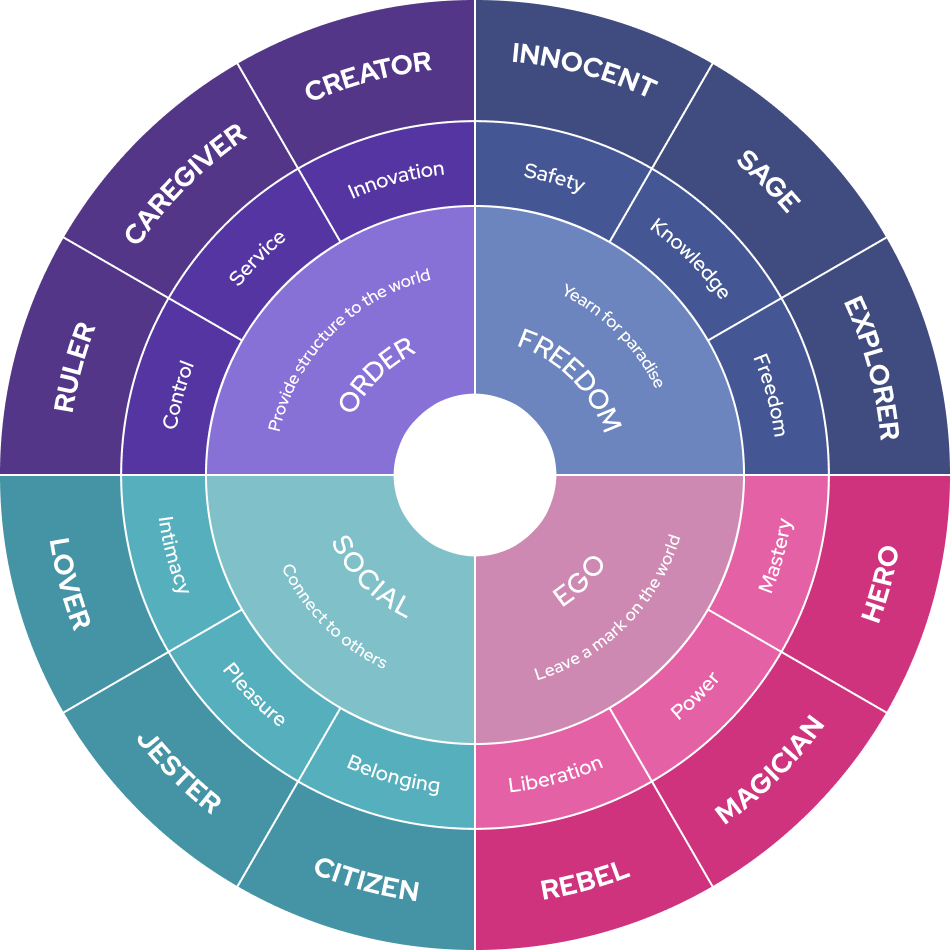
What Are Brand Archetypes (and Why They’re the Secret to Building a Magnetic Brand)
Ever wonder why some brands feel alive—while others fade faster than a half-off logo template?
The difference isn’t luck or budget. It’s psychology.
Brand archetypes are the emotional DNA behind the world’s most iconic brands. They’re the “why” behind every color, word, and campaign that makes your audience say, “This brand gets me.”
If your brand’s vibe feels fuzzy—or worse, forgettable—this is your cue to dig deeper.

What Exactly Is a Brand Archetype?
At its core, a brand archetype is your brand’s personality—the human traits your audience instinctively recognizes and connects with.
The concept comes from Carl Jung’s theory of universal characters—those timeless roles we see repeated in myths, movies, and stories. Think: the Hero who saves the day, the Rebel who breaks the rules, the Caregiver who heals.
In branding, archetypes translate that storytelling power into strategy.
They help your visuals, voice, and messaging align—so you’re not one person on Instagram and another on your website.

Why Brand Archetypes Matter
Here’s the thing about brand archetypes:
They’re not just some fancy marketing framework. They’re your secret weapon for building real emotional connections with your people.
Why? Because humans don’t buy with their brains—they buy with their hearts.
Your customers aren’t sitting around comparing feature lists on a spreadsheet. They’re making decisions based on how you make them feel. And if your brand storytelling hits them right in the emotions? That’s when the magic happens.
Brand archetypes help you tap into those emotions in a way that feels authentic, consistent, and unmistakably you. Because in a world where everyone’s screaming for attention, the brands that win are the ones that make people feel something real.
When you identify your archetype, your brand becomes consistent, memorable, and magnetic. It’s what turns “we design websites” into “we empower local businesses to stand out.”
A clear archetype helps you:
- Speak in a recognizable tone
- Build emotional trust faster
- Differentiate from competitors
- Create visuals and messaging that feel like you
Without it? You’re just throwing fonts and buzzwords at the wall and hoping something sticks.

The 12 Brand Archetypes (with Examples)
1. The Innocent — “Pure, optimistic, and honest.”
Wants to do things right and make people happy.
Examples: Dove, Aveeno, Coca-Cola.
Use it if: Your brand celebrates simplicity, goodness, or nostalgia.
2. The Explorer — “Freedom is everything.”
Thrives on adventure, discovery, and self-reliance.
Examples: Patagonia, The North Face, Jeep.
Use it if: You help people push limits or find their own path.
3. The Sage — “Knowledge is power.”
The thoughtful guide who values truth and wisdom.
Examples: Google, TED, National Geographic.
Use it if: You educate, inform, or simplify complex ideas.
4. The Hero — “Courage. Determination. Achievement.”
Overcomes challenges to inspire others.
Examples: Nike, FedEx, Gatorade.
Use it if: You motivate people to be their best selves.
5. The Rebel — “Rules were meant to be broken.”
Rebellious, bold, and unapologetically different.
Examples: Harley-Davidson, Diesel, Virgin.
Use it if: You stand for disruption and self-expression.
(Sound familiar? This one’s got Studiolit energy written all over it.)
6. The Magician — “Turn dreams into reality.”
Transforms the ordinary into the extraordinary.
Examples: Disney, Apple, Dyson.
Use it if: You help customers experience transformation or wonder.
7. The Everyman — “We’re all in this together.”
Friendly, relatable, and down-to-earth.
Examples: Target, IKEA, Budweiser.
Use it if: You value connection, comfort, and belonging.
8. The Lover — “Passion, beauty, and emotional connection.”
Wants to create intimacy and delight.
Examples: Chanel, Godiva, Haagen-Dazs.
Use it if: You help people feel special, desired, or indulged.
9. The Jester — “Life’s too short to be boring.”
Brings joy, humor, and playfulness to everything.
Examples: M&M’s, Old Spice, Fanta.
Use it if: You help people have fun and not take life too seriously.
10. The Caregiver — “Compassion is power.”
Protective, nurturing, and service-driven.
Examples: Johnson & Johnson, Pampers, TOMS.
Use it if: Your focus is helping, healing, or supporting others.
11. The Creator — “Inspiration in every pixel.”
Innovative, expressive, and driven by originality.
Examples: Lego, Adobe, Crayola.
Use it if: You help others build, imagine, or express themselves.
12. The Ruler — “Command. Structure. Excellence.”
Values control, order, and leadership.
Examples: Rolex, Mercedes-Benz, Microsoft.
Use it if: You lead with authority and give customers a sense of status or security.
How to Find Your Brand Archetype
You might see yourself in more than one archetype—and that’s okay. Most strong brands are a blend of a primary and secondary archetype.
But the key is clarity: your brand needs one dominant energy that drives your tone, visuals, and story.
That’s exactly what we uncover inside the Brand Ignition Workshop — your guided deep-dive into who your brand really is (and how to make it unforgettable).
By defining your archetype, we’ll shape everything from your voice and visuals to your customer experience—so your audience doesn’t just see you; they feel you.

Ready to Unbland Your Brand?
Your archetype is more than a personality quiz—it’s the foundation of your brand strategy.
When you know who you are, your design, copy, and marketing finally click into place.
No more generic templates. No more “meh” messaging. Just big-brand polish, hometown heart, and clarity.
Want help defining yours? Check out my Brand Strategy Page.
Big-brand polish.
Small-town roots.
Studiolit helps you stand out where it counts.
Share this article: